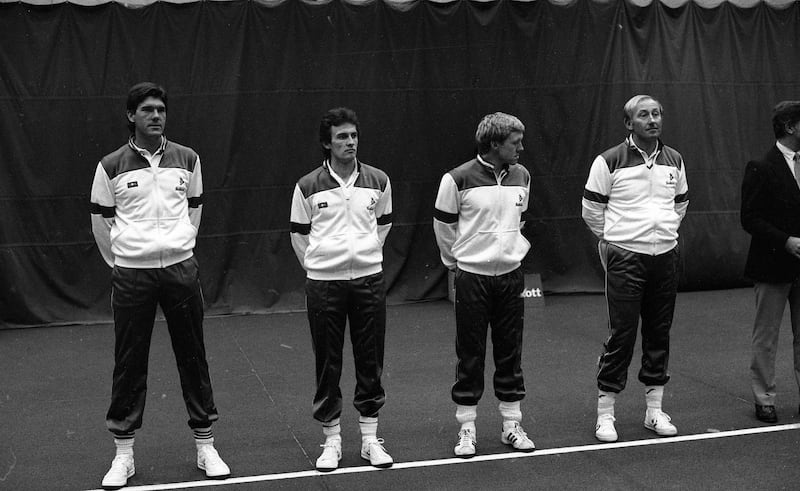Matt Doyle, who suddenly died last week aged 70 at his home in Straffan in Kildare, lived at least two lives. One was as a golfer in The K Club, where he became a fixture, and another as a professional tennis player in the John McEnroe and Jimmy Connors era of the 1980s.
It was McEnroe he lost to on his highest ever ascent in a Grand Slam event, the last 16 of the US Open in 1982.
It could be said Doyle also had a third life in the USA, where he grew up and went to college before arriving in Ireland oversized, sun-kissed and with a west coast smile. From his home in Redwood City, he came with a little piece of Irish heritage and a larger piece of Californian glamour to brighten up an otherwise dowdy Ireland of the 1980s.
He almost immediately energised the Irish tennis scene, gave the game a profile and presence that it has not had since, and added a dimension that tennis didn’t previously possess, a big-serving game and a confident personality.
Have your say: Who is the greatest Irish sports star of them all?
Michael Watson and the incredible relationship he shares with the man who saved his life
How a sports psychologist helped Rory McIlroy live with the raging doubts and secure career Grand Slam
Shane Lowry set for quick return to action following Masters disappointment
A Yale economics graduate, Doyle wasn’t your average tennis jock. He had obvious intelligence and that was often conveyed through a razor-sharp wit. Nobody was too big or too important to be caressed by his charm. Invariably his quips were friendly, sometimes close to the bone and, in his younger days, playfully risqué.
He could be a boyish rascal, but was always intellectually capable and, importantly, he was funny. That combination of traits made him likable and interesting company and earned him many more friends than enemies.
Whether it was true or not, Doyle always gave the impression that he didn’t need to work. An abiding image is of his 6ft 4in sitting at the spike bar in The K Club as he pored over the coloured newsprint of the Financial Times or Wall Street Journal. The commonly held assumption was that he was checking the companies in which he had made investments to support this apparent post-tennis life of leisure.
Nobody really knew but it added to the legend of an urbane former tennis pro following his stock options at one of the most prestigious golf clubs in the country.
An aspiring basketball player, Doyle took to golf and became the number one player in Yale. Another career twist took him to tennis. That agility to move from one place to another was a feature that led him to become the figure who presided over the formation of the new Association of Tennis Professionals (ATP) Tour when it was founded in 1989.
By then he was well known throughout the world, as he starred, along with Sean Sorensen, in the Davis Cup match staged in the RDS in 1983. In Ireland’s only ever appearance in the World Group they drew gold, with the USA the opponents in Dublin’s RDS.

The Irish team lost but tennis won hearts and minds. Although Doyle’s big serve kept him in the match against McEnroe and he went down 9-7, 6-3, 6-3, he was able to claim a World Group victory by beating Eliot Teltscher 6-3, 6-4, 6-4.
In his post playing career Doyle became a coach to Mats Wilander, who in the late 80s had become the world number one player. An appreciation recently published on the ATP Tour website spoke of Doyle’s tactical awareness.
“Hit your forehand harder, Matt told me,” Wilander said to the ATP. “I told him my forehand was very solid, and I rarely missed. He said the same thing about my first serve. Basically, he was telling me not to worry about making a few more mistakes. It worked.”
Wilander, who had won the French Open as a teenager in 1982, went on to win at the Australian Open, Roland Garros and US Open in 1988 with Doyle at his side.
He was also involved with RTÉ as both a tennis and golf commentator, covering Wimbledon and the Ryder Cup when it was staged in The K Club in 2006, and was immersed in the charity Goal.
Doyle was in the umpire’s chair when McEnroe played Wilander in a Goal exhibition match in Trinity College’s New Square, where a grass tennis court was marked out and temporary scaffold seating erected.
On another occasion in 1989 and just a week before Wimbledon, the same two tennis gods were convinced to climb into the ring for a boxing exhibition by the persuasive John O’Shea, all of it lubricated and kept moving by the gregarious Doyle.
Doyle didn’t return to California but became an Irish citizen in the 1980s and played for and coached the Irish Davis Cup team, although he was more than a player and a coach. He coloured the scene with charisma, a dry wit and worldly curiosity.
He will be remembered as the dashing and transformative Irish player from California, who was ranked inside the top 100, played the Slams, knew McEnroe and coached Wilander.
Suaimhneas síoraí dá anam


















